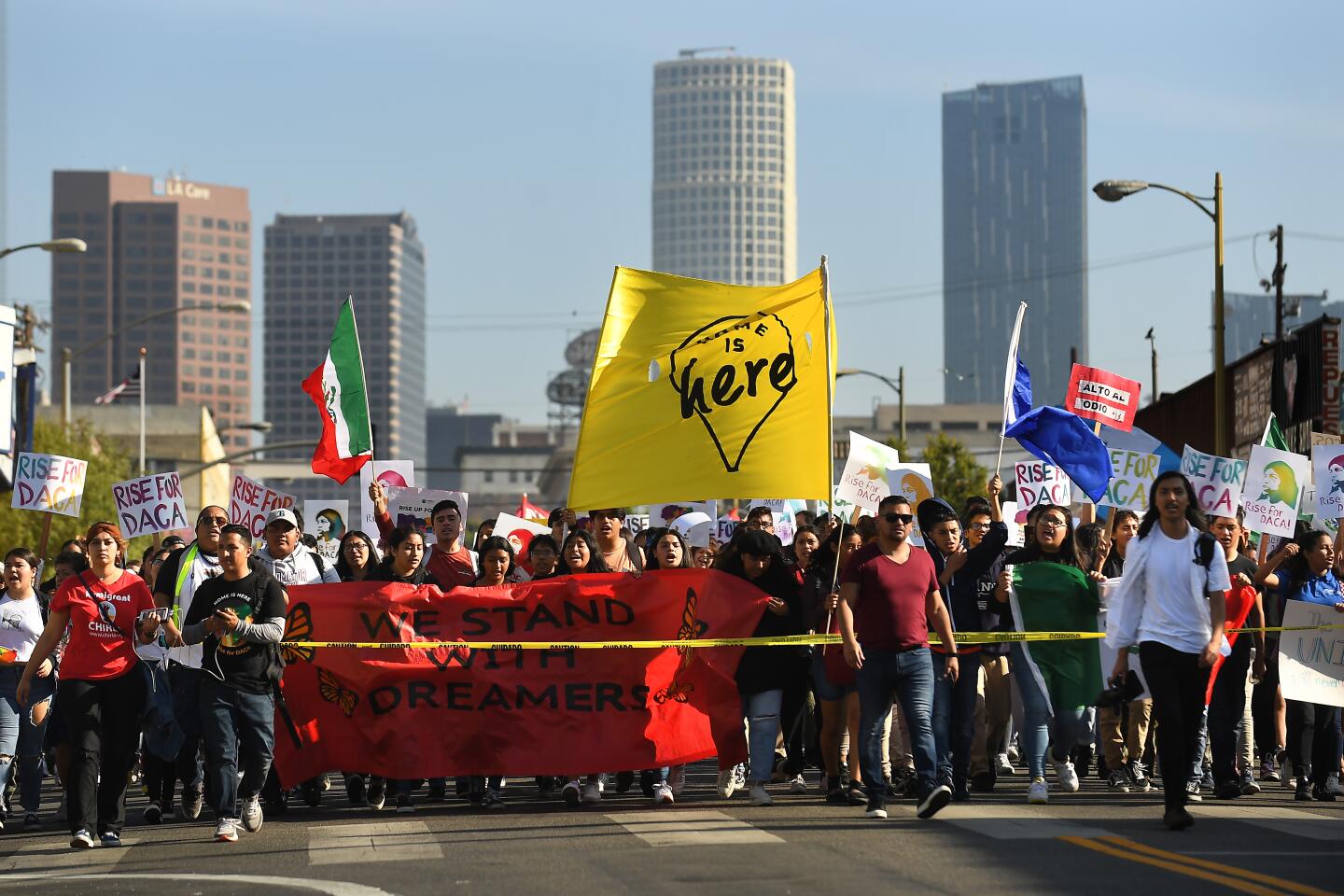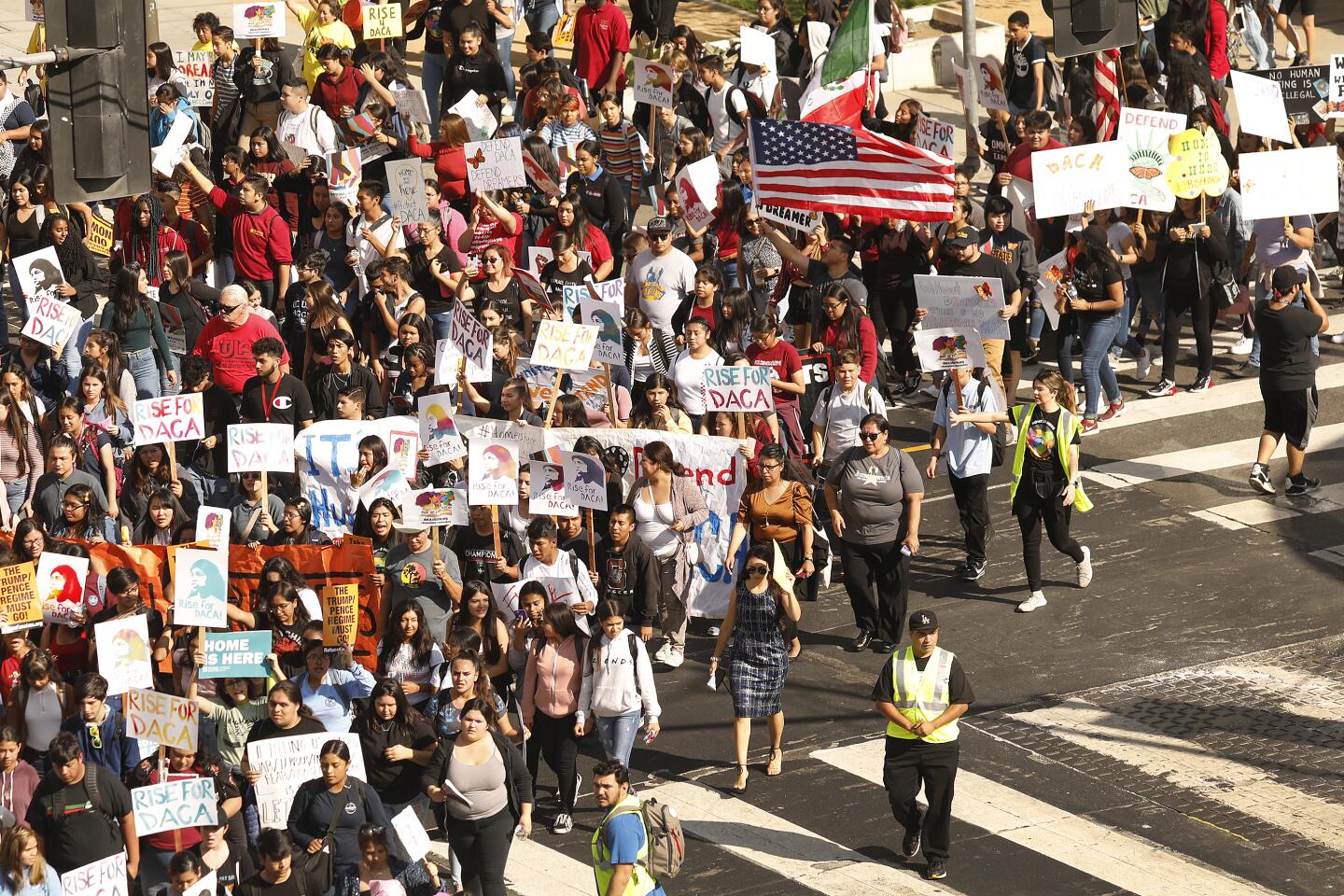DACA march: Supreme Court hearing prompts hundreds of L.A. students to walk out
- Share via
Hundreds of Los Angeles students, some carrying signs reading “Our dreams are not illegal” and “Rise for DACA,” walked out of class Tuesday and rallied downtown after the U.S. Supreme Court heard arguments about the legality of a policy that protects 700,000 young immigrants from deportation.
At James A. Garfield Senior High School in East Los Angeles, dozens of students silently streamed out of classrooms just before 10 a.m. Susie Flores, 16, was in AP English listening to a podcast about President Trump’s effort to rescind the Obama-era program called DACA, short for Deferred Action for Childhood Arrival. She walked out to support two friends who are undocumented.
For the record:
7:09 p.m. Nov. 12, 2019Jazmin Ramirez Morales is a student at Cal State L.A. A previous version of this article misidentified her as a USC student.
“Your education is the biggest weapon that you own,” said Susie, a junior. Her friends want “to pursue the typical American Dream” and the repeal of DACA makes that much harder, she said.
Organizers for East L.A. advocacy groups stood along the street outside the school, toting wagons of water and snacks and handing out “know your rights” pamphlets to the group of at least 200.
Samantha Barrientos, 16, a student activist with the Coalition for Humane Immigrant Rights of Los Angeles (CHIRLA), organized the Garfield walkout. Holding a bullhorn and leading chants, she guided fellow students to the metro station.
An 11th grader whose sister received DACA, Barrientos had a message for the justices: “Take into consideration that these recipients have families now. They are very welded into their communities. They are parents, they are siblings, they are our community, they are our people.“
Other participants said they walked out to show the Trump administration and Supreme Court justices that young people are willing to give up a day of education to secure the fates of their peers, friends and families. They chanted their way down Atlantic Boulevard, on the metro, and up to the Federal building downtown, where they joined hundreds of other students and community members in a rally.
LAUSD school board member Monica Garcia spoke outside the building. “Let us do our job, see our students for the amazing gift they are,” she said.
Joseph Caballero, 15, arrived with classmates from Sotomayor Arts and Sciences Magnet school in Glassell Park on a bus with school chaperones. It was his first protest, and it made him want to get more involved in activism, he said.
Older demonstrators said the fight to preserve DACA feels like history is repeating itself.
Nely Rodriguez, 39, remembers students taking to the streets in 1994 after Gov. Pete Wilson ushered in Prop 187, a ballot measure that restricted immigrants rights and access to services in California.
In 1998, Rodriguez graduated from Garfield High School. She was undocumented and washed dishes for $2 an hour, unable to afford the out-of-state tuition that undocumented students then had to pay to attend public colleges and universities in California.
“Just watching these kids march, it brings back memories ... feeling trapped, you know, not having options. No way of advancing yourself. It’s depressing,” she said.
Eventually Rodriguez gained citizenship. She enrolled in UCLA in 2016 and is about to complete an undergraduate degree in Spanish and Chicana/Chicano studies.
Rodriguez said it’s sad to see young people struggling for the same rights she sought two decades ago, especially after DACA offered a brief reprieve to part of a generation. “How many of these kids are going to end up washing dishes, too?” she asked.
Jazmin Ramirez Morales, 28, a master’s candidate in social work at Cal State L.A., came to the U.S. from Mexico at age 3, driven across the border by a family friend. She remained in the country without legal status, with her parents. After graduating from high school in Lennox, she lived at home and worked cash jobs, mostly in fast food restaurants, to pay for college. With the California Dream Act and DACA, she found a stable job at T-mobile and secured enough financial aid to finish college. The work authorization allowed her to work at nonprofits and as a foster care caseworker.
Ramirez Morales said she, too, wishes teens today did not have to experience the same uncertainty and hurdles she did 10 years ago, but admires the activism of this generation.
“I want people to know that we matter,” she said. “We contribute to society, we’re homeowners, we pay taxes.”
Around noon the hundreds of protesters at the Federal building began a march to MacArthur Park, filling the sidewalk and roadways. Some banged drums improvised from buckets, while others cheered and waved signs and flags amid chants. After reaching the park nearly two hours later, some students returned to schools on buses while many stayed for more rallying and a concert.
Los Angeles Unified officials said that students whose parents or guardians check them out for “DACA-related events” will have their absences excused. Students who remain in school will have the opportunity to discuss immigration reform in class and talk about how the pending Supreme Court decision could affect local communities.
In 2016, LAUSD Supt. Austin Beutner signed an amicus brief supporting the expansion of DACA.
“DACA has protected nearly 800,000 young immigrants from deportation, allowing them to pursue a good education, a good job and a better life,” Beutner said in a statement Tuesday.
Times staff writer Nina Agrawal contributed to this report.
More to Read
Sign up for Essential California
The most important California stories and recommendations in your inbox every morning.
You may occasionally receive promotional content from the Los Angeles Times.

























